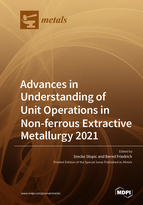Advances in Understanding of Unit Operations in Non-ferrous Extractive Metallurgy 2021
A special issue of Metals (ISSN 2075-4701). This special issue belongs to the section "Extractive Metallurgy".
Deadline for manuscript submissions: closed (31 December 2021) | Viewed by 51415
Special Issue Editors
Interests: environmental protection; recycling; metallurgy; mineral processing; nanotechnology; waste water treatment
Special Issues, Collections and Topics in MDPI journals
Interests: pyrometallurgy; process technology; metals; recycling; purification; alloying; WEEE; spent batteries; critical materials; circular economy; electrometallurgy
Special Issues, Collections and Topics in MDPI journals
Special Issue Information
Dear Colleagues,
The high demand for critical materials, such as rare earth elements, indium, gallium, and scandium, raises the need for an advance in understanding of the unit operations in non-ferrous extractive metallurgy. Unit metallurgical operations processes are usually separated into three categories: 1) hydrometallurgy (leaching, mixing, neutralization, precipitation, cementation, crystallization), 2) pyrometallurgy (roasting, smelting), and 3) electrometallurgy (aqueous electrolysis and molten salt electrolysis). In hydrometallurgy, the aimed metal is first transferred from ores and concentrates to a solution using a selective dissolution (leaching; dry digestion) under an atmospheric pressure below 100 °C and under a high pressure (40-50 bar) and high temperature (below 270°C) in an autoclave and tube reactor. The purification of the obtained solution was performed using neutralization agents such as sodium hydroxide and calcium carbonate or more selective precipitation agents such as sodium carbonate and oxalic acid. The separation of metals is possible using liquid/Liquid process (solvent extraction in mixer-settler) and solid-liquid (filtration in filter-press under high pressure). Crystallization is the process by which a metallic compound is converted from a liquid into a solid crystalline state via a supersaturated solution. The final step is metal production using electrochemical methods (aqueous electrolysis for basic metals such as copper, zinc, silver and molten salt electrolysis for rare earth elements and aluminum). Advanced processes, such as ultrasonic spray pyrolysis and microwave-assisted leaching, can be combined with reduction processes in order to produce metallic powders. Some preparation for the leaching process is performed via a roasting process in a rotary furnace, where the sulphidic ore was first oxidized in an oxidic form which is a suitable for the metal transfer to water solution. During the smelting process, the target metal is further refined at high temperatures and reduced to its pure form. The pyrometallurgical treatment of the ore was performed in an electric furnace and combined with a refining during distillation. Unit Operations in Non-ferrous Extractive metallurgy can be successfully used for the recovery of non-ferrous metals from secondary materials.
Prof. Dr. Bernd Friedrich
Dr. Srecko Stopic
Guest Editors
Manuscript Submission Information
Manuscripts should be submitted online at www.mdpi.com by registering and logging in to this website. Once you are registered, click here to go to the submission form. Manuscripts can be submitted until the deadline. All submissions that pass pre-check are peer-reviewed. Accepted papers will be published continuously in the journal (as soon as accepted) and will be listed together on the special issue website. Research articles, review articles as well as short communications are invited. For planned papers, a title and short abstract (about 100 words) can be sent to the Editorial Office for announcement on this website.
Submitted manuscripts should not have been published previously, nor be under consideration for publication elsewhere (except conference proceedings papers). All manuscripts are thoroughly refereed through a single-blind peer-review process. A guide for authors and other relevant information for submission of manuscripts is available on the Instructions for Authors page. Metals is an international peer-reviewed open access monthly journal published by MDPI.
Please visit the Instructions for Authors page before submitting a manuscript. The Article Processing Charge (APC) for publication in this open access journal is 2600 CHF (Swiss Francs). Submitted papers should be well formatted and use good English. Authors may use MDPI's English editing service prior to publication or during author revisions.
Keywords
- hydrometallurgy
- pyrometallurgy
- electrometallurgy
- leaching
- digestion
- solvent extraction
- precipitation
- electrolysis
- molten salt electrolysis
- cementation
- roasting
- smelting
- refining
- ultrasonic spray pyrolysis
- microwave leaching
- recycling







